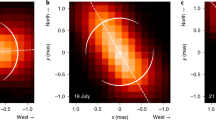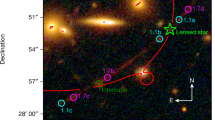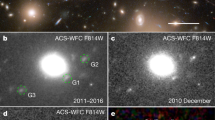Abstract
Gravitational microlensing offers a means of determining directly the masses of objects ranging from planets to stars, provided that the distances and motions of the lenses and sources can be determined1,2. A globular cluster observed against the dense stellar field of the Galactic bulge presents ideal conditions for such observations because the probability of lensing is high3 and the distances and kinematics of the lenses and sources are well constrained. The abundance of low-mass objects in a globular cluster is of particular interest, because it may be representative of the very early stages of star formation in the Universe, and therefore indicative of the amount of dark baryonic matter in such clusters. Here we report a microlensing event associated with the globular cluster M22. We determine the mass of the lens to be 0.13+0.03-0.02 solar masses. We have also detected six events that are unresolved in time. If these are also microlensing events, they imply that a non-negligible fraction of the cluster mass resides in the form of free-floating planetary-mass objects.
This is a preview of subscription content, access via your institution
Access options
Subscribe to this journal
Receive 51 print issues and online access
$199.00 per year
only $3.90 per issue
Buy this article
- Purchase on Springer Link
- Instant access to full article PDF
Prices may be subject to local taxes which are calculated during checkout


Similar content being viewed by others
References
Paczyński, B. Gravitational microlensing in the Local Group. Annu. Rev. Astron. Astrophys. 34, 419–459 (1996).
Schneider, P., Ehlers, J. & Falco, E. E. Gravitational Lenses (Springer, Berlin, 1993).
Paczyński, B. Gravitational Microlensing by the Globular Cluster Stars. Acta Astronomica 44, 235–239 (1994).
Paresce, F., De Marchi, G. & Romaniello, M. Very low mass stars and white dwarfs in NGC 6397. Astrophys. J. 440, 216–226 (1995).
Elson, R. A. W., Gilmore, G. F., Santiago, B. X. & Casertano, S. HST observations of the stellar population of the globular cluster Ω Cen. Astron. J. 110, 682–692 (1995).
King, I., Anderson, J., Cool, A. M. & Piotto, G. The luminosity function of the globular cluster NGC 6397 near the limit of hydrogen burning. Astrophys. J. 492, L37–L40 (1998).
De Marchi, G. & Paresce, F. Low mass stars in globular clusters II. The mass function of M15. Astron. Astrophys. 304, 202–210 (1995).
Burrows, A., Hubbard, W. B., Saumon, D. & Lunine, J. I. An expanded set of brown dwarf and very low mass star models. Astrophys. J. 406, 158–171 (1993).
Gilliland, R. L. et al. A lack of planets in 47 Tucanae from a Hubble Space Telescope search. Astrophys. J. 545, L47–L51 (2000).
Marcy, G. W., Butler, R. P. Planets orbiting other suns. Publ. Astron. Soc. Pacif. 112, 137–140 (2000).
Alcock, C. et al. The MACHO project: microlensing results from 5.7 years of Large Magellanic Cloud observations. Astrophys. J. 542, 281–307 (2000).
Afonso, C. et al. Microlensing towards the Small Magellanic Cloud EROS 2 two-year analysis. Astron. Astrophys. 344, L63–L66 (1999).
Udalski, A. et al. The optical gravitational lensing experiment. Catalog of microlensing events in the galactic bulge. Acta Astron. 50, 1–65 (2000).
Yanagisawa, T. et al. Wide-field camera for gravitational microlensing survey: MOA-cam2. Exp. Astron. 10, 519–535 (2000).
Sahu, K. C. Stars within the Large Magellanic Cloud as potential lenses for observed microlensing events. Nature 370, 275–276 (1994).
Sahu, K. C. Microlensing events of the LMC are better explained by stars within the LMC than by MACHOs. Publ. Astron. Soc. Pacif. 106, 942–948 (1994).
Sahu, K. C. & Sahu, M. S. Spectroscopy of MACHO 97-SMC-1: Self-lensing within the Small Magellanic Cloud. Astrophys. J. 508, L147–L150 (1998).
Cudworth, K. M. & Hansen, R. B. Space velocities of 14 globular clusters. Astron. J. 105, 168–172 (1983).
Peterson, R. C. & Cudworth, K. M. Proper motions and radial velocities in the globular cluster M22 and the cluster distance. Astrophys. J. 420, 612–631 (1994).
Stetson, P. B. in Stellar Photometry—Current Techniques and Future Developments (eds Butler, C. J. & Elliot, I.) 291–303 (IAU Colloq. 136, Cambridge Univ. Press, Cambridge, 1993).
Dominik, M. Galactic microlensing with rotating binaries. Astron. Astrophys. 329, 361–374 (1998).
Paczynski, B. P. Binary source parallactic effect in gravitational micro-lensing. Preprint astro-ph/9711007 at 〈http://xxx.lanl.gov/〉 (1997).
Freeman, K. C., de Vaucouleurs, G., Wainscoat, R. J. & de Vaucouleurs, A. A spectroscopic determination of the velocity dispersion in the Galactic bulge. Astrophys. J. 325, 563–565 (1988).
Bode, M. F. & Evans, A. E. Classical Novae 5 (Wiley & Sons, Chichester, 1989).
Warner, B. Cataclysmic variable Stars 148 (Cambridge Univ. Press, Cambridge, 1995).
Downes, R. et al. A catalog and atlas of cataclysmic variables—the living edition. Publ. Astron. Soc. Pacif. (in the press).
Della Valle, M. & Livio, M. Are microlensing events contaminated by dwarf nova eruptions? Astrophys. J. 457, L77–L79 (1996).
Samus, N., Kravtsov, V., Pavlov, M., Alcaino, G. & Liller, W. A new photographic colour-magnitude study of M 22 = NGC 6656. Astron. Astrophys. Suppl. Ser. 109, 487–499 (1995).
Pettersen, B. R. A review of stellar flares and their characteristics. Sol. Phys. 121, 299–312 (1989).
Acknowledgements
N.P. is on assignment from the Space Science Department of ESA. We thank H. Duerbeck, J. Valenti, H. Bond, R. Downes and J. Pringle for discussions.
Author information
Authors and Affiliations
Corresponding author
Rights and permissions
About this article
Cite this article
Sahu, K., Casertano, S., Livio, M. et al. Gravitational microlensing by low-mass objects in the globular cluster M22. Nature 411, 1022–1024 (2001). https://doi.org/10.1038/35082507
Received:
Accepted:
Issue Date:
DOI: https://doi.org/10.1038/35082507
This article is cited by
-
Planetary candidates
Nature (2001)
Comments
By submitting a comment you agree to abide by our Terms and Community Guidelines. If you find something abusive or that does not comply with our terms or guidelines please flag it as inappropriate.



